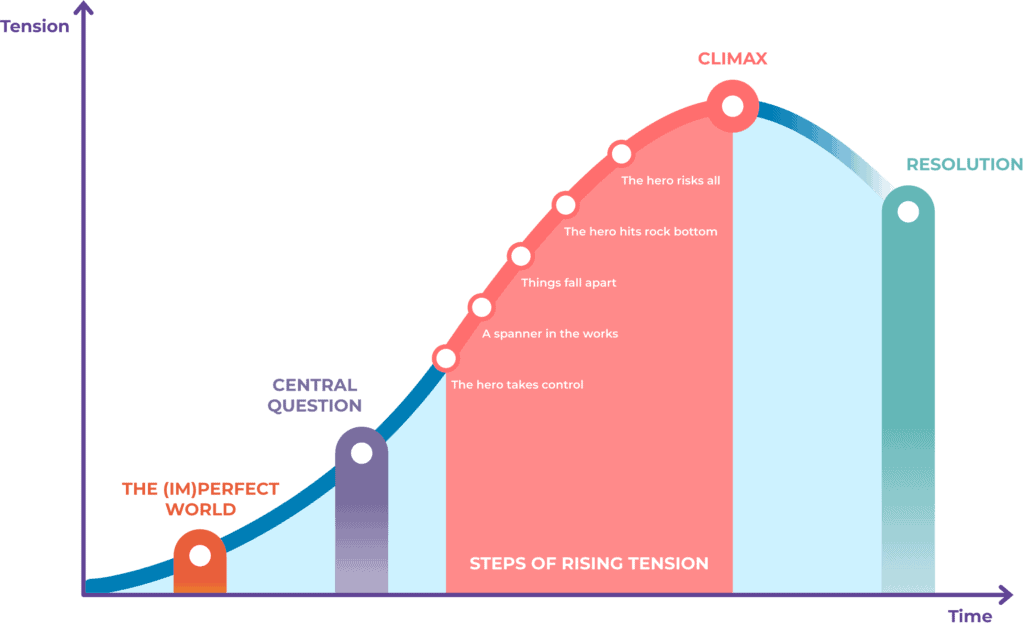Storytelling
There are 8 essential elements to building a story. Humans enjoy stories that follow the basic structure and we have become very good at applying this structure to our stories. The elements build tension, meaning that we want to find out what happens next.
In the age of the ‘attention economy’ where it is no longer a given that people will pay attention, storytelling is vital to ensure the audience is pulled to the end of the story in an engaging way. While the story elements seem like a Hollywood formula, they can easily be applied to campaigns and projects.
The following is a graph that illustrates the ‘arc of tension’ – a visualisation of the key elements.

Tension and time
Tension is the feeling an audience has from trying to figure out what happens next. A story requires the tension to build, so our desire to find a solution to the problem posed in the story gets greater and greater as the story progresses. As humans are problem-solving creatures, we want to be confronted with a problem we want to solve, we make an assumption about how the problem will be solved and then we see if our assumption is correct. This tension must rise during the story. We do not like stories that go nowhere or stories that have very low tension.
Time relates to story time. A story may happen in a few minutes or may take decades. What is important is that the period is chosen for maximum tension. Can the story best be told chronologically? Or is it more suspenseful to use flashbacks?
The (im)perfect world
All great stories start by showing us a perfect world. Even if the world we enter into as the audience is not a perfect world, for the people in the story it is. This perfect world ends when the central question is introduced.
The central question
The central question is a yes-or-no question. It can be: “Will the hero win the heart of the girl?”. Once the perfect world has been introduced, we need to be confronted with a problem or quest that the hero must solve. This question will draw the audience to try and find the answer through the story. The answer will be given in the climax of the story. Until the climax, the viewer must ask him- or herself what could happen next?
Rising tension
Rising tension is created by events that the character responds to. Humans like twists and turns and stories that have challenges that the hero faces. A good story presents lots of obstacles. We want to see the hero try and fail, try and fail and fail and try again until they succeed. Without obstacles in the way (the steps of rising tension), we feel cheated and disengage from the story.
For example:
- The hero takes control
- A spanner in the works
- Things fall apart
- The hero hits rock bottom
- The hero risks all
Climax
The climax is the answering of the central question. It is the moment in the story in which the character is rewarded or punished for adopting new behaviours; it is a moment of irreversible change. In this part of the story we learn the answer to the question we have been waiting for throughout the story.
Resolution
A resolution is the consequence of the story. Usually the hero is rewarded, and the enemy punished. Order is restored, and a new perfect world is established. The most common ending in fiction is ‘and they lived happily ever after…’ to conclude the world of the narrative. This is created to give the audience a concluding emotion. A resolution shows the reward the character has earned and demonstrates a positive or negative emotion in the audience towards what has been learnt.
Symbol
A symbol is not a structural component of a story. Rather it is a story device. A symbol in a story is more than a symbol in language. A story symbol has specific requirements and is defined differently than something that is ‘symbolic’.
A symbol is a name, a place, an object or anything:
- That has meaning beyond itself
- Whose meaning changes from the beginning of the story to the end
- That is culturally understood
Universal truth
A story is “something that happens to someone that teaches us something”. The universal truth is the moral premise of the story, something we learn as an audience. It is usually attitudinal and based on an emotional shift. The universal truth is the deeper meaning of the story, it is what the audience is left with at the conclusion and is usually a strong argument and an attitudinal lesson.
Key takeaways
- Story is the way humans enjoy getting information as it contains emotion.
- Story does not mean “Fiction” rather it’s the structuring of information in a way that makes it engaging.
- Humans are problem solving creatures and therefore we enjoy seeing the struggle to find a solution more than being given the solution (steps of rising tension).
- Symbols are essential as these are shorthand to local cultures and sensibilities.
